Security 2016 Exhibition in Melbourne gave us a chance to take a look at the latest product releases, get a sense of trends, as well checking out some of the vapourware teasers that manufacturers and distributors roll out at big events.
SECURITY 2016 had a nice feel – it’s a good venue and the square layout at the MCEC somehow mitigates the sense of being tucked away in far corners. The organisers quoted visitor numbers of around 4500, which seemed slightly optimistic from behind Sony’s New York Loft Bar. Regardless, it was another good show considering this was a third year in Melbourne thanks to the ongoing revamp of the Exhibition and Convention Centre in Darling Harbour. While some exhibitors were jumping to conclusions on the first day, by the end of the show on Friday afternoon, most were happy with the turnout and quality of the visitors they’d seen.
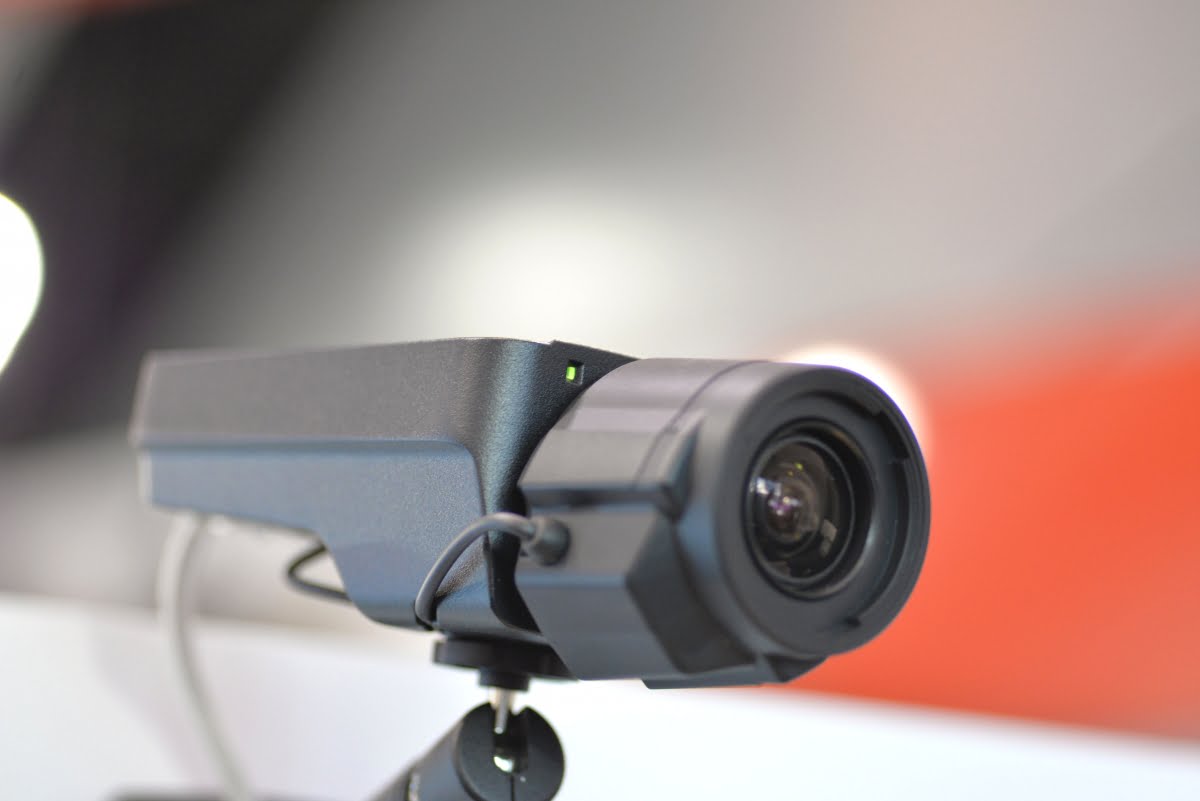
At the same time, some visitors expressed a desire to see more snap from their exhibitors – there were requests for quality drones from more than one quarter, as well as some comments on the sameness of the solutions visitors had seen. A number of installers said there was nothing that really grabbed them at the show this year – that cameras were conforming to form factor and alarm systems tending to the cloud. It’s likely this latter sense reflects the maturity of the market more than anything else. However, all these comments do say something pertinent about what Security 2016 means from the point of view of the latest product releases.
I visited many stands at Security 2016 – as usual I needed an extra day to see them all – and in almost every case my first port of call was a huge monitor on which was displayed the latest video or security management solution, depending on the level of integration the developers had attained. Many stands had multiple instances of powerful software engines designed to weave inputs and outputs into ever more complex operational tapestries.
It’s not that hardware wasn’t prevalent, often beautiful in appearance and execution, but software was king at Security 2016 even if manufacturers and distributors were playing down the old chestnut of licensing fees per door/per camera, as though it really were possible to bring to market a self-evolving software application without the need to monetise its development.
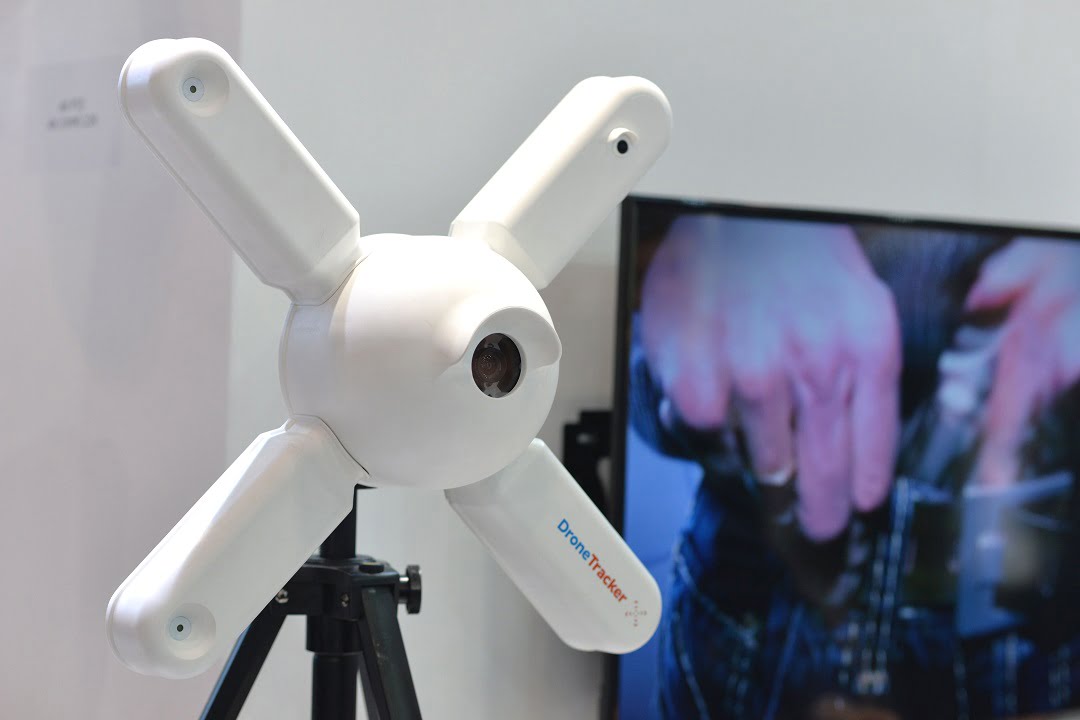
Considered from a temporal standpoint, we’ve gone from a time when management solutions were frightening Microsoft NT dragons that threatened to consume engineers brave enough to hunt them and fry end users whose paths they crossed, to a different place. The best management solutions, together witth their attendant apps and browsers, feel tilted on the curl of a mighty comber, more than ever expressing a power that will sweep the industry forward. Touching the fingertips of metaphor in a technical magazine might seem too much but words like ‘integration’ and ‘seamless’ and ‘intuitive’ are too smeared with toil to infuse the mind with our future’s gathering energy.
Of course, the future is not just about security management software because we’re part of a wider revolution that’s most clearly visible at random moments – a time you walk past a huge crowd on a balmy night at Bennelong Point and realise all are back-turned to Opera House and hanger bridge, faces aglow with the future’s light. Row upon row of kids are on Facebook, others on Viber, backpackers are scrolling through maps, a couple reads a review of the restaurant they are standing out front of – that one’s not very good, I tell them. On and on up the pink granite walk are hundreds upon hundreds of connected engagements wherever you look.
It’s part of a global change that makes customised PSIM seem an archaic concept, a profound shift that challenges the one-dimensionality of siloed software solutions and feeds into the expectations of customers whose minds are daily lit by the flickering tips of oceanic fibres, drinking from rivers of data, charging ahead of the blunt instrument of the 3-year product turnover, asking ‘why can’t I?’.
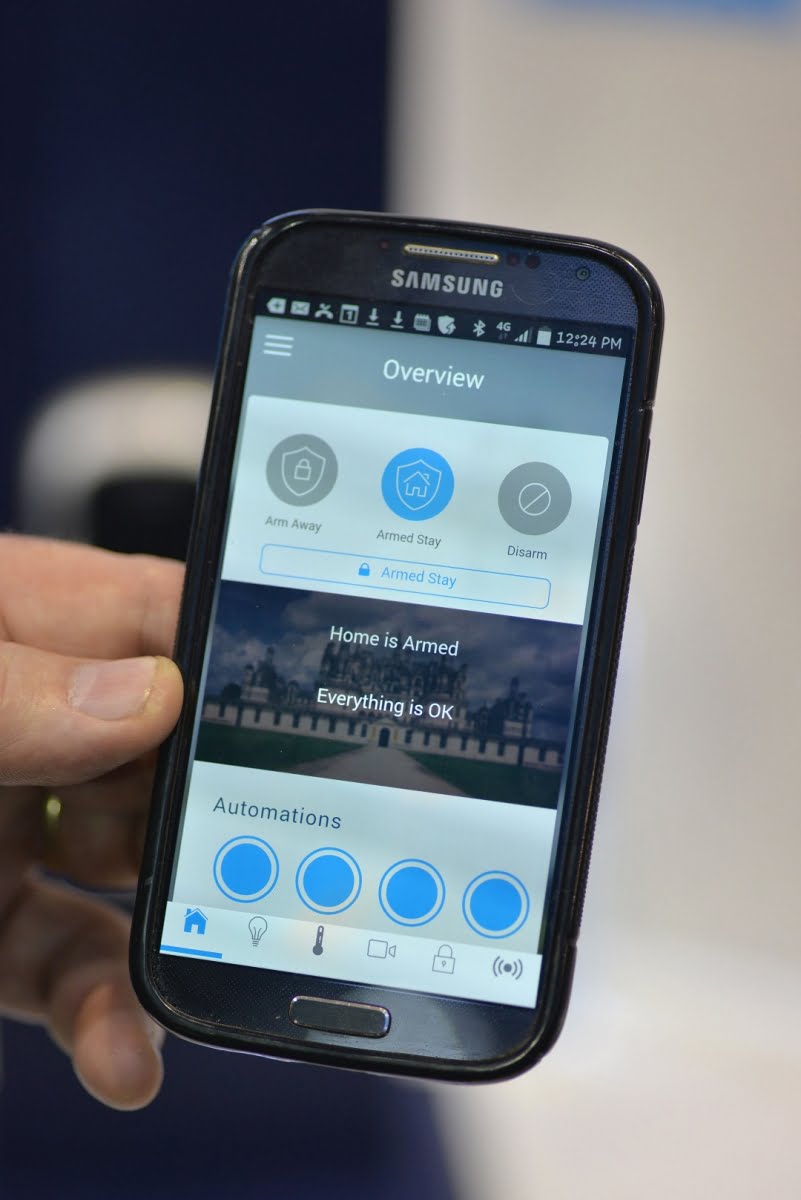
Change is there in the processing power of an Axis camera which makes corrections to an iCS lens at 60 frames per second to eliminate barrel distortion at 2.8mm. It’s there when a man from Singapore tells you he’s looking forward to his half-gig internet upgrade because 100Mbps isn’t enough. It’s there in alarm panels that look like toys yet hustle triple layers of comms, and in intelligent video analysis that turns onerous investigations into proactive processes that inform security operations teams in near real time.
What can you manage with this solution? I ask. What can’t you manage? comes the reply. This system is designed to integrate multiple sub systems on a single interface, displaying the site in almost 3 dimensions of graphics and system functionality for real time response to unfolding events. How hard is it to program this access control solution? I ask. You just follow the prompts for doors, or for cameras, or alarm inputs, or POS events, or IVA events pertaining to marketing. And using this other software you can bring everything together – you click an icon that represents the functionality – there’s no physical integration, it’s all IP.

Then there’s the excitement building around H.265, a real revolution in the nature of compression that’s beginning to liberate networked video in a way no one can quite comprehend – it’s going to be felt laterally – while combining it with analytics and inputs in ways that make any image stream operationally meaningful. What is the video surveillance industry? It’s whatever you need to see. In the compression race now are Dahua with H.265, Axis with Zipstream, Hikvision with Smart H.264, Vivotek with Smart Stream II and Samsung with WiseStream. Zipstream is a capable solution and Vivotek’s H.265 Smart Stream II, which claims to reduce bandwidth demand 80 per cent is also something to pay attention to. We saw at SecTech Camera shootout in May that Vivotek’s cameras had extraordinarily tight bitrates for their resolutions.
We’ve been coming to this intoxicating point for a long time now but at Security 2016 you really felt the gravity of the digital underpinnings of the world, drawing us all in.
What was new in CCTV
New things at Security 2016 in CCTV included Hikvision’s extremely powerful PanoVu DP1636Z-D, which incorporates multiple Darkfighter cameras in a panoramic array with an integrated PTZ. Together with clever software, PanoVu is able to capture panoramic images as well as close-up images, while advanced video analysis and a multiple target tracking algorithm incorporated.
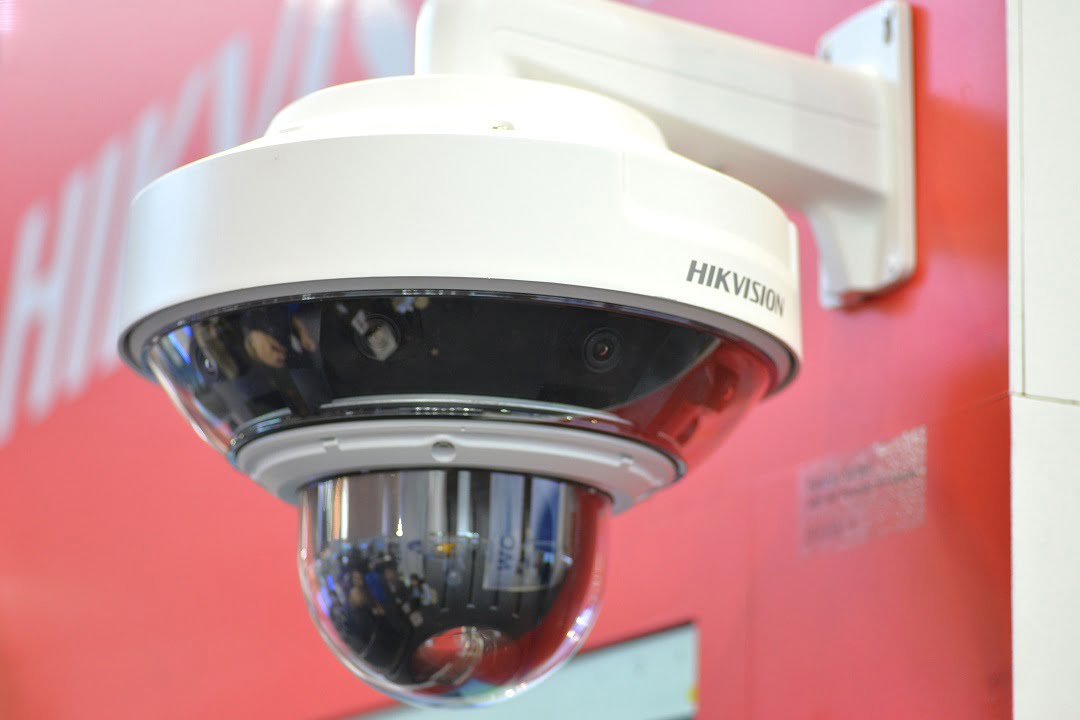
There was a new IR PTZ from Vivotek, a powerful new dome from Uniview, the new glass fibre AeroPTZ and 1080p compact cameras from Panasonic, new cameras from Canon and Sony – some we saw at SecTech and others were shown for the first time. Sony’s VB770 was set up in a darkroom in a corner of Sony’s neat stand where it ran off against the VB630 in a series of low light tests that went down under 1 lux. You have to hand it to Sony. The 4K VB770 with an ISO rating of 409,600 is the best pure CCTV camera on the planet in low light at the moment, with rampant amplification and excellent control of noise working together.
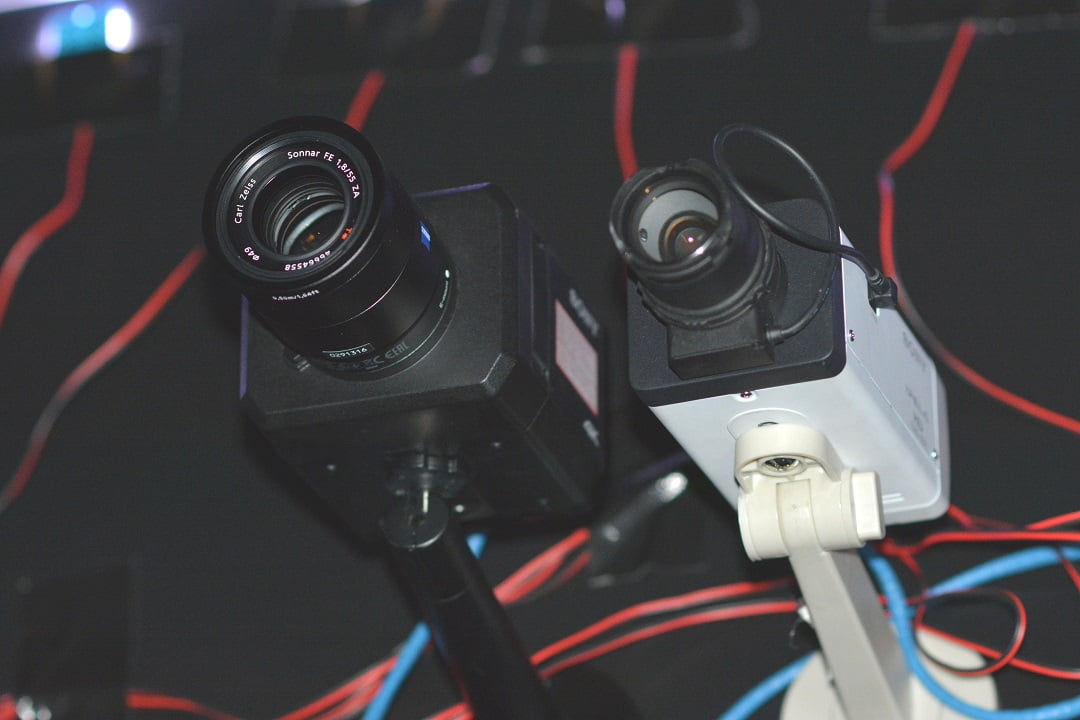
It’s true that many makers have conformed to a uniformity of form factor in CCTV and while everyone seems to have low end cameras, there were plenty of higher end cameras at the show – not just at the very top end with 36x domes, but powerful fixed cameras with integrated housings and attractive pricing – these included the IPC-HFW8331E-Z from Dahua and the Uniview 22x optical Starlight bullet. Something else that was noticeable was the continuing push into digital analogue from Dahua, Hikvision and others. The attraction of such solutions is low cost hardware, high resolution, low latency and the ability to lever existing coaxial cables.
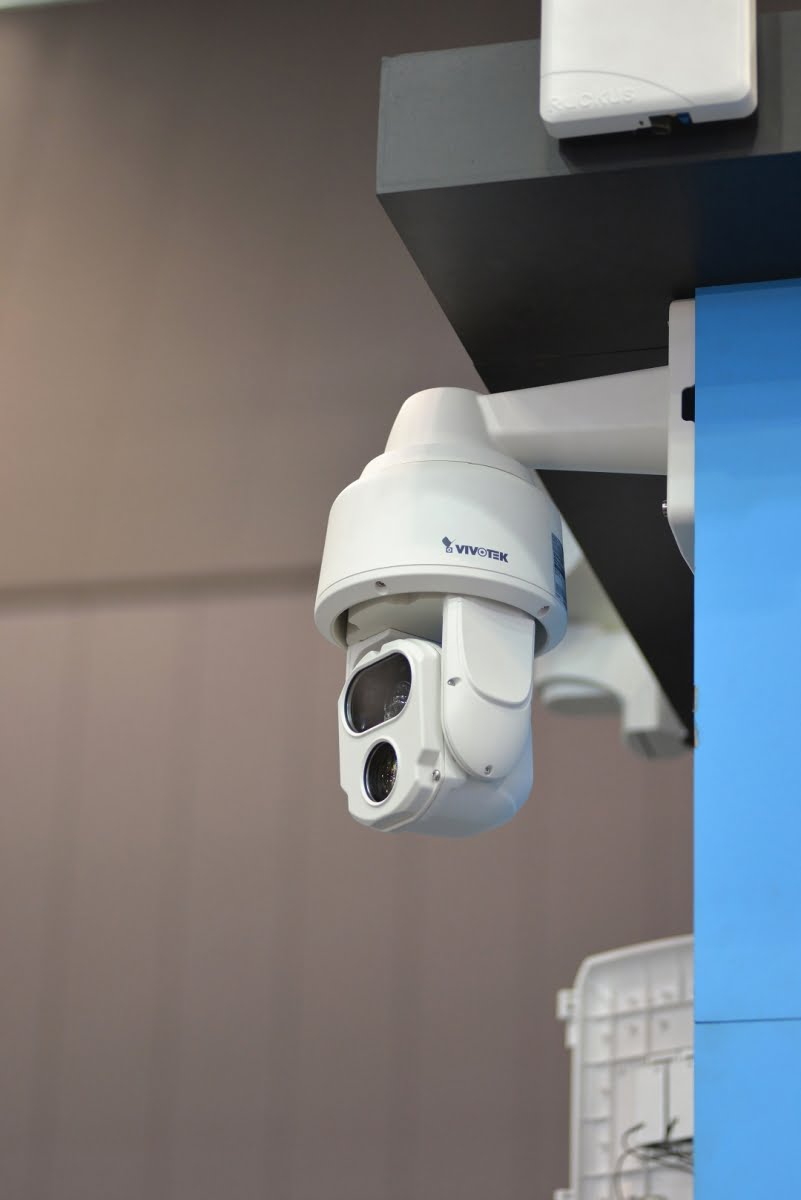
I got a kick out of the Axis Q1615 Mark II, which incorporates the i-CS lens. We’re used to clever things from Axis, including Zipstream, but the Q1615 Mark II with i-CS lens is a bellwether. Camera processors are now powerful enough to offer 4 separate 1080p video streams at up to 50ips and clever compression, while at the same time correcting lens aberrations – barrel distortions – as well as offering easy application specific setup that can be tweaked remotely.
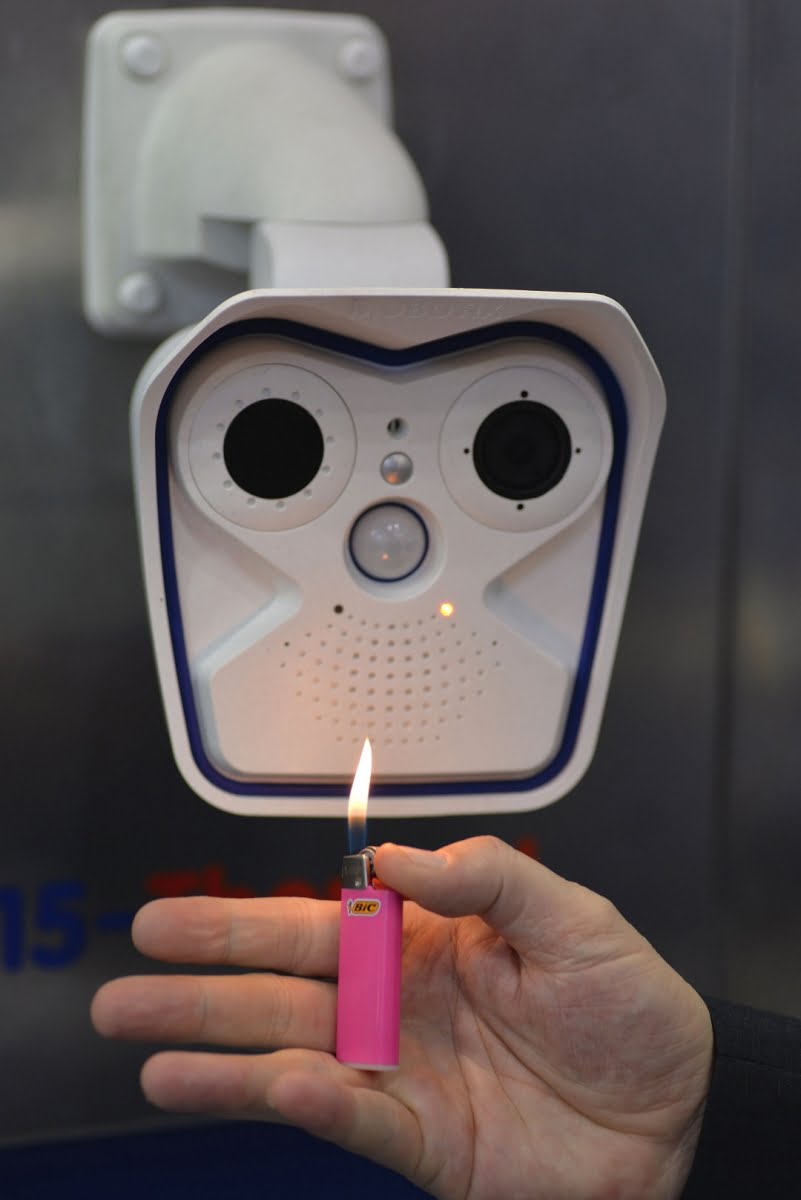
Along with a new compact wide angle video intercom, Axis also showed compact multi-headed cameras. Vivotek’s MS8391-EV also has 4 x 3MP CMOS sensors giving a 180-degree angle of view. Vivotek’s SD9364-EHL was showing on the Hills’ stand. It’s said to be the first PTZ surveillance camera with IR Illumination to utilize H.265 compression technology, which reduces bandwidth by 80 per cent compared with H.264 – that’s a big deal. This camera has an impressive spec, with 1080p full HD resolution to go with its H.265, 150m IR illuminators, VAIR, WDR, and 30x optical zoom, IP66- and NEMA 4X-rated housing and a decently wide operating temperature range between -50 and 55C.

Uniview’s new fisheye with 12MP of resolution, IR, IK10 and IP66 was notable. Meanwhile, Pelco showed its Optera 180-degree video surveillance camera. Canon’s VB-H761LVE was another standout. It’s a weather and impact-resistant infrared bullet camera with a sensitive 1/3-inch Full HD CMOS sensor, fast auto focusing, 20x optical zoom lens, 60m infrared range and multiple built-in analytics. This is another in a new generation of relatively compact high performance fixed bullet cameras with great optics and IR support that are ideal for serious surveillance application in public, commercial and industrial spaces.

Uniview also leaned in on the C.R. Kennedy stand, showing a 2MP Starlight bullet with 22x zoom and 200 metres of IR. Very interesting specs, these. Uniview wasn’t finished there. The company also showed a Starlight PTZ dome with 2MP of resolution (1080p), 44x optical zoom and 250 metres of IR range. Wow. This dome was an impressive piece of kit and the exhibition hall simply wasn’t large enough to give us a sense of its potential. There was also a pan/tilt bullet with 100m of IR, 2MP 1080p resolution and 2x optical zoom, as well as other units.
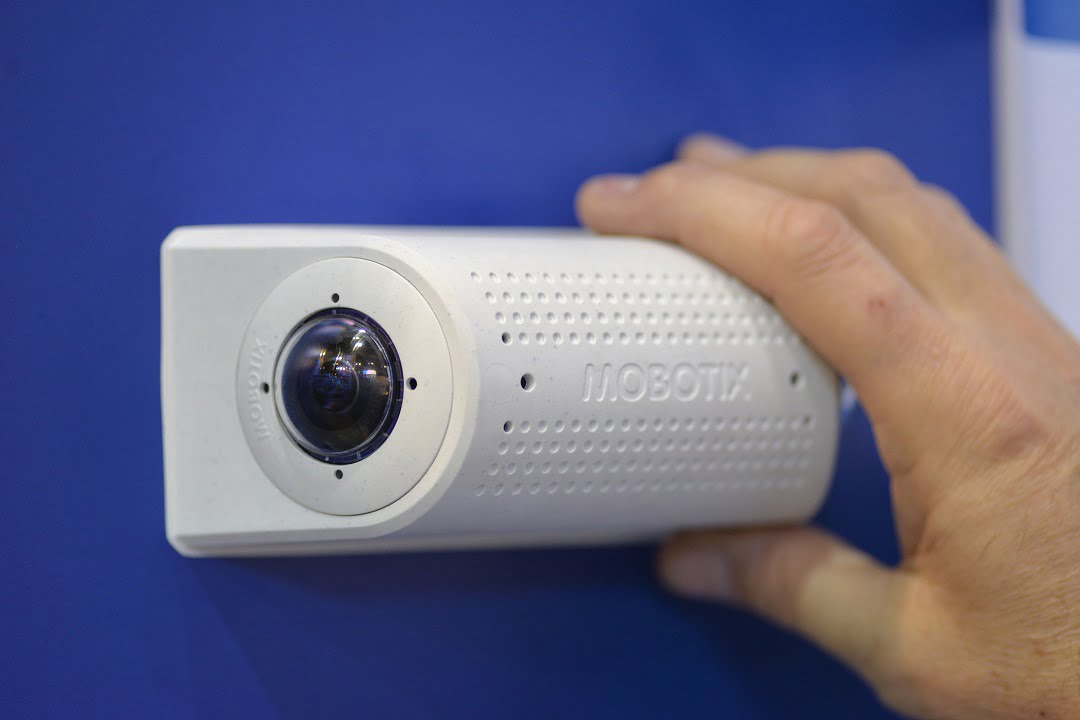
On the EOS stand, was the powerful Samsung 4K Wisenet P Series, along with H.264 and H.265 with WiseStream. Samsung has also released a new range of affordable compact domes and bullet cameras, as well as compact, capable and affordable NVRs.
Avigilon showed the H4 Edge and Dahua rolled out some neat new cameras, too, including the distinct-looking DH-IPC-PFW8601, a multi-head camera that can provide a 180-degree panoramic flat view without edge distortion, along with a digital PTZ function. This camera employs Sony starlight image technology for low light performance. The camera features H.265 encoding and highly intelligent features such as people counting and heat mapping.
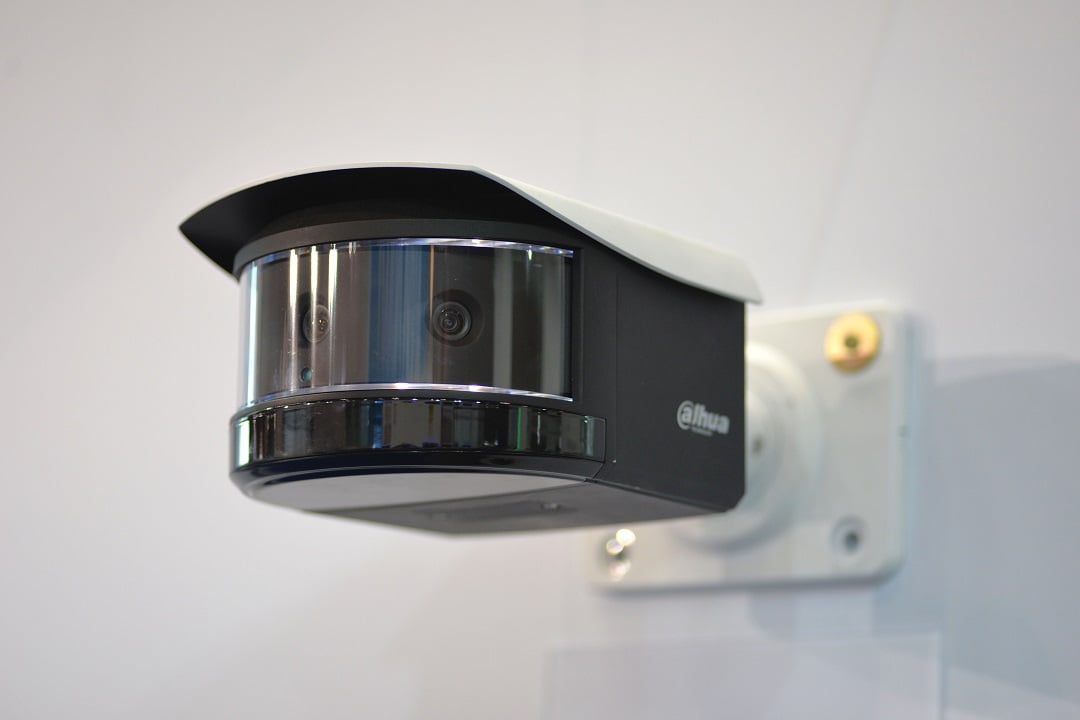
Panasonic’s 1080p AeroPTZ features 30x optical zoom, IP67 and IK10 ratings, along with NEMA-4X, image stabilisation and a fibreglass body that’s impervious to the challenges of tough marine environments. I liked Hikvision’s tiny new compact, new cameras from FLIR, Mobotix flame detection capability incorporated into MxActivitySensor and Mobotix Dual Thermal 6MP thermal cameras. An interesting release in CCTV from Hills was the VZ-215IPM 21.5-inch LED screen. With full HD and the ability to run Android apps. It comes with an Ethernet 10/100 port and 2 USB ports. This monitor with onboard Android OS connects to your server or IP cameras for streaming live video, eliminating the need of a client PC. The monitor is ONVIF Profile S compliant and connects like a camera to a user’s network.
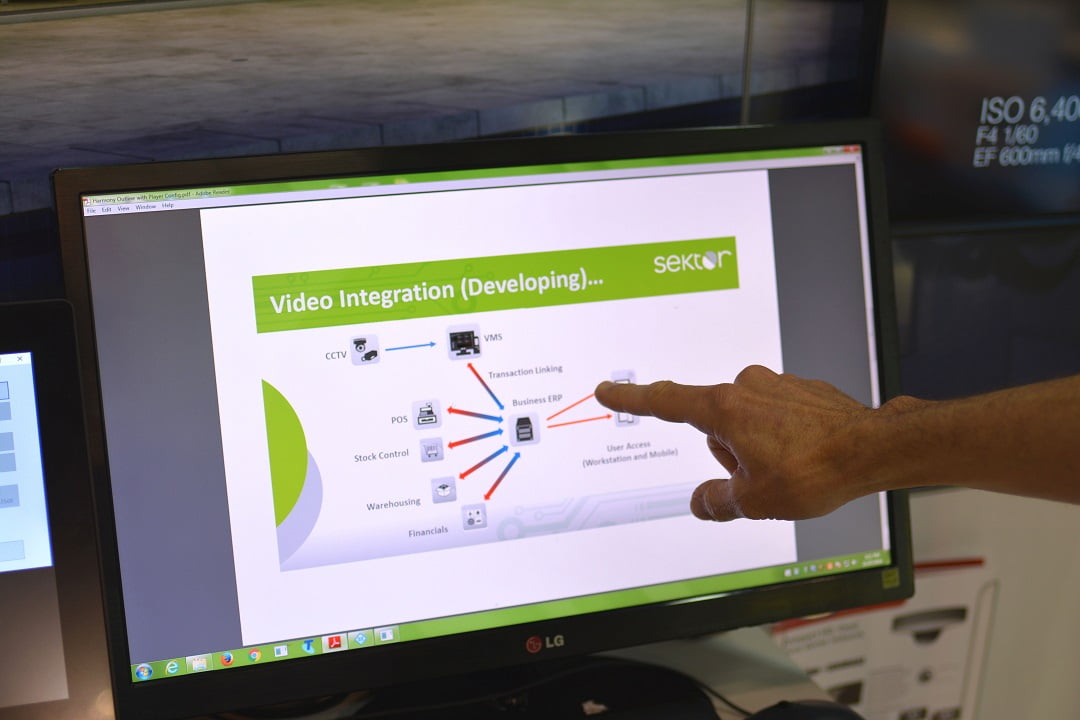
Management software was a feature of the show and the functionality of these systems showed that developers have grown their systems out of their VMS roots. For instance, Pelco’s VideoExpert includes analytics, license plate recognition, POS integration and alarm and event management. Sektor’s very clever Harmony Transaction Player contrives to integrate with multiple manufacturers systems to offer access to CCTV that’s link to PoS, stock control, warehousing and more. Genetec’s Security Centre, which scales from very capable to all powerful, is much than a VMS and Genetec’s Mission Control takes this to a whole new level by wrangling Security Center’s capabilities into shapes that offer the best operational response to multitudinous incidents. There’s mapping and graphics integrating video feeds, event reporting, incident management, procedures and operator response workflow and auditing.
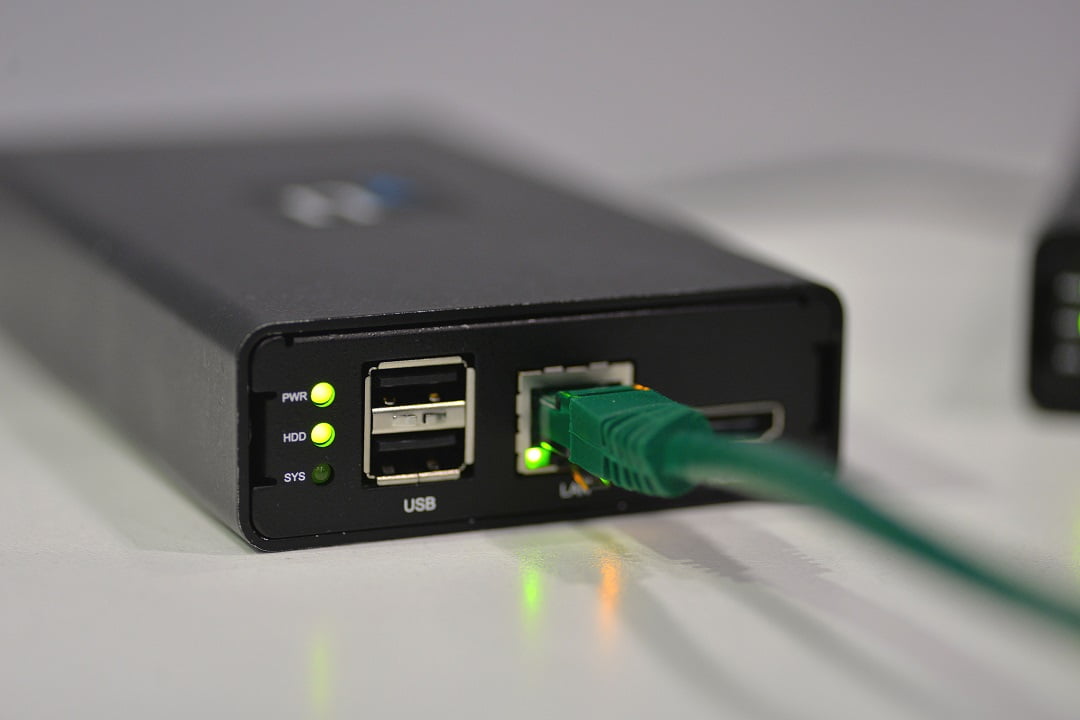
Aimetis Symphony 7 is another VMS that does plenty more. It does everything with cameras locally or on mobile devices, has alarm notification and log, linked site map and event-driven timeline. It’s particularly strong in analytics, with motion tracking, object classification, people and vehicle counting, automatic license plate recognition, virtual fence, loitering and dwell time and auto-PTZ tracking. There were other solutions from ONSSI and Samsung. The NX Witness VMS from MGTS stood out for its organic user interface that had a strong Mac feel to it in terms of the ability to just do anything you like – pull an image over here and expand it. Do it again and again – throw in analytics – it’s got tons of functionality yet the organisation of functionality does not restrict the operator. You have to wheel your way through its operations yourself to get a feel for it – driving NX Witness gives that rollercoaster feeling you get when steering a quality hemispheric camera browser but this isn’t a single camera you’re burrowing into, it’s an entire CCTV solution.
NX Witness uses an HTTP Generic Event API and VCA’s burn-in analytics so users can quickly integrate video analytics that are viewable on both live and recorded video displayed in the NX Witness client. Suitable for both surveillance and business intelligence applications. This system has a simple and intuitive user interface and without any complex engineering controls users can define a detection rule in just a few mouse clicks. Captured events from cameras can be used to create bookmarks, do live video text overlay and launch alarm layout.
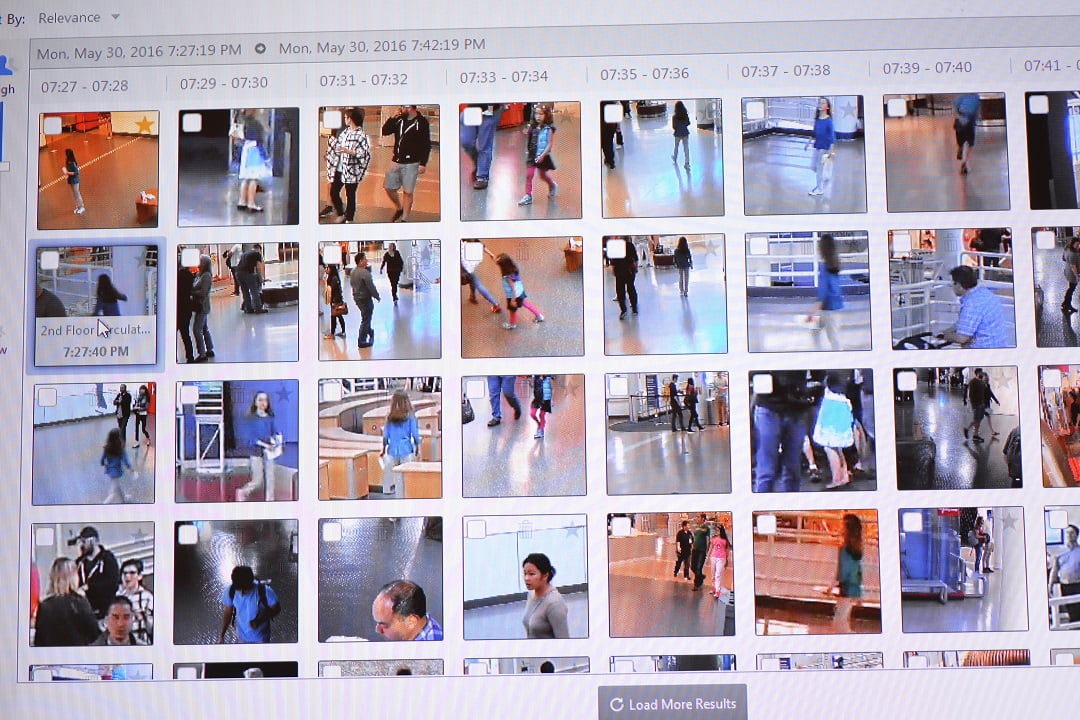
Avigilon’s Appearance Search was another winner, I thought – if not best in show, it was very close. It was tough to get a proper run-through of this system as Avigilon is particular when talking to the media so I watched one of the team conduct a search in silence – it’s a credit to the solution that I had no trouble understanding what Appearance Search was capable of after watching the demo.
Essentially, what this solution does is allow you to run a search of all video inputs for a particular individual (or object) and have the system displays in thumbnails all the closest possible matches that an operator then elevates to the top of the display by tagging. If you want to watch the footage, click on the tile. Just typing it out like this doesn’t really do the flexibility and power of the system justice, nor does it give a sense of its ability to allow investigators to filter out the movements of a person through a huge site like a shopping mall or airport while capturing every moment of video footage they’re captured in without the need to sit down and watch every feed in real time.
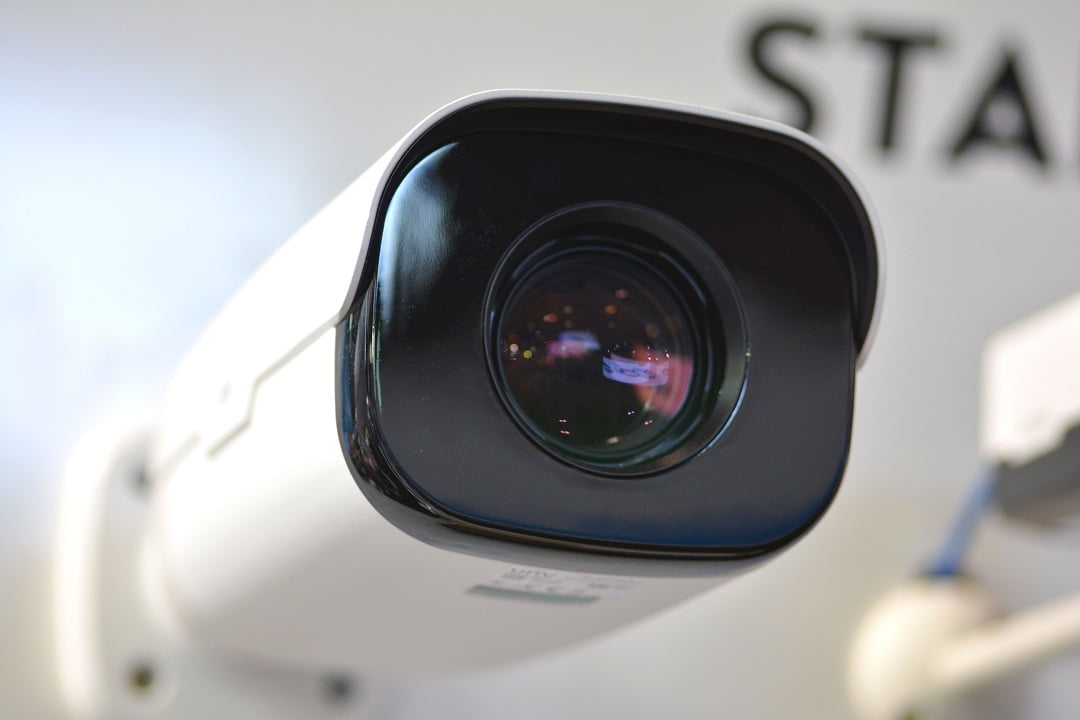
A key part of the puzzle is server and storage architecture and Quantum’s Xcellis Application Director revealed itself as the front end of projects from 50-150 cameras. What’s so pleasing about Quantum is that the company is a networking animal and it delivers what you need wherever and however its possible – flash drives, high performance hard drives, standard hard drives, file-based tape, and the Cloud. What Quantum is pushing for is high performance, large storage capacity and low TCO – Quantum says 40 per cent less than traditional HDD solutions.
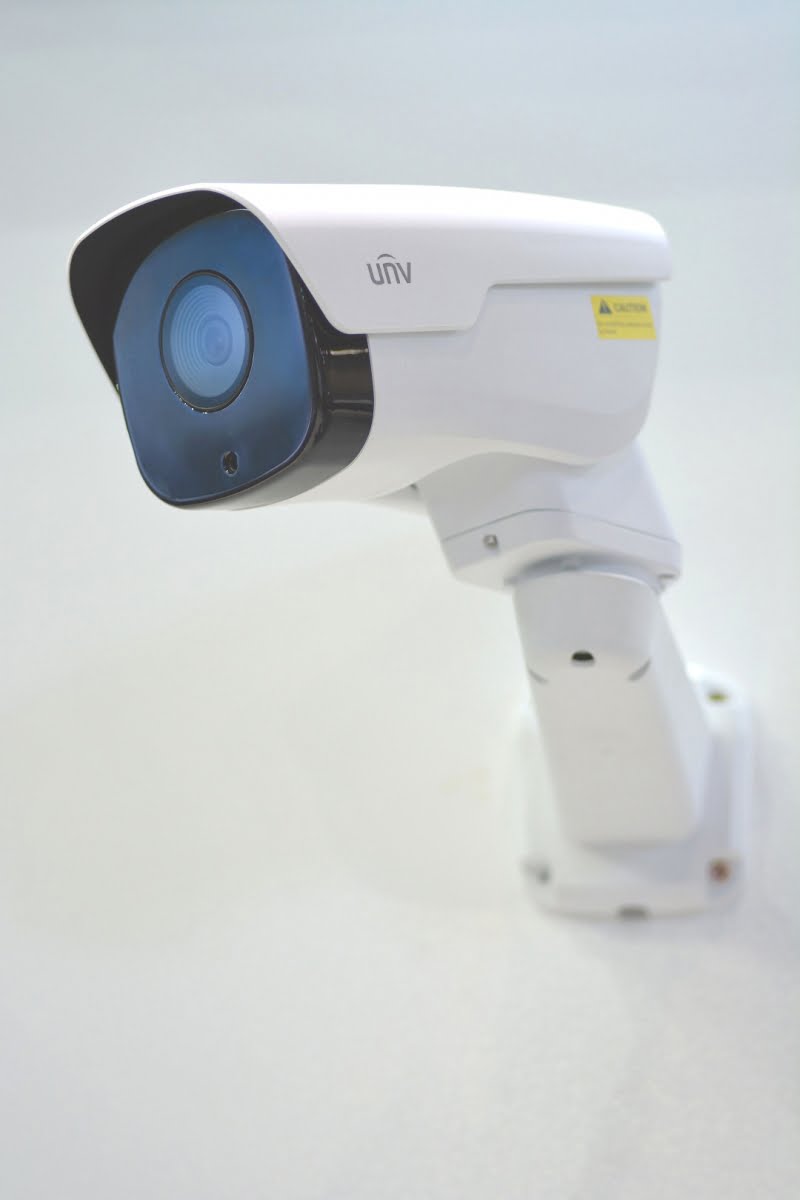
In the area of comms, SCSI DirectConnect attracted attention. It’s a secure and reliable 4G Fixed-IP service that connects CCTV, access control, BMS, medical alert, in fact any IP device, via SCSI’s VPN. DirectConnect is deployed through a standard 4G router and because DirectConnect is a communications device that facilitates connection with existing hardware, the best way to understand it is as part of an application. Bandwidth is between 30-70Mbps download and around 15Mb upload depending on where you are in relation to the tower, which is exceptionally fast. DirectConnect is not for live streaming but for motion detection or to allow remote viewing when required with real time video stored on an individual mobile camera or on a local NVR.
What was new in access control
Developments in access control continue in multiple directions and there was more going on in this area than I expected to see. The main takeaway from Security 2016 was the continuing evolution of compact yet modular systems that empower installers and users in ways formerly impossible. The whole modular thing in access control is by no means new – manufacturers have talked modular for 25 years. What’s changed is the overlay of a ubiquitous broadband WAN that can be accessed anywhere – it doesn’t matter which entry point users employ to access the global WAN – the WAN’s presence allows them to manage a small system remotely and to link multiple small systems into a seamless whole. Something else that stands out is the level of remote control users have over their systems – it’s profound.
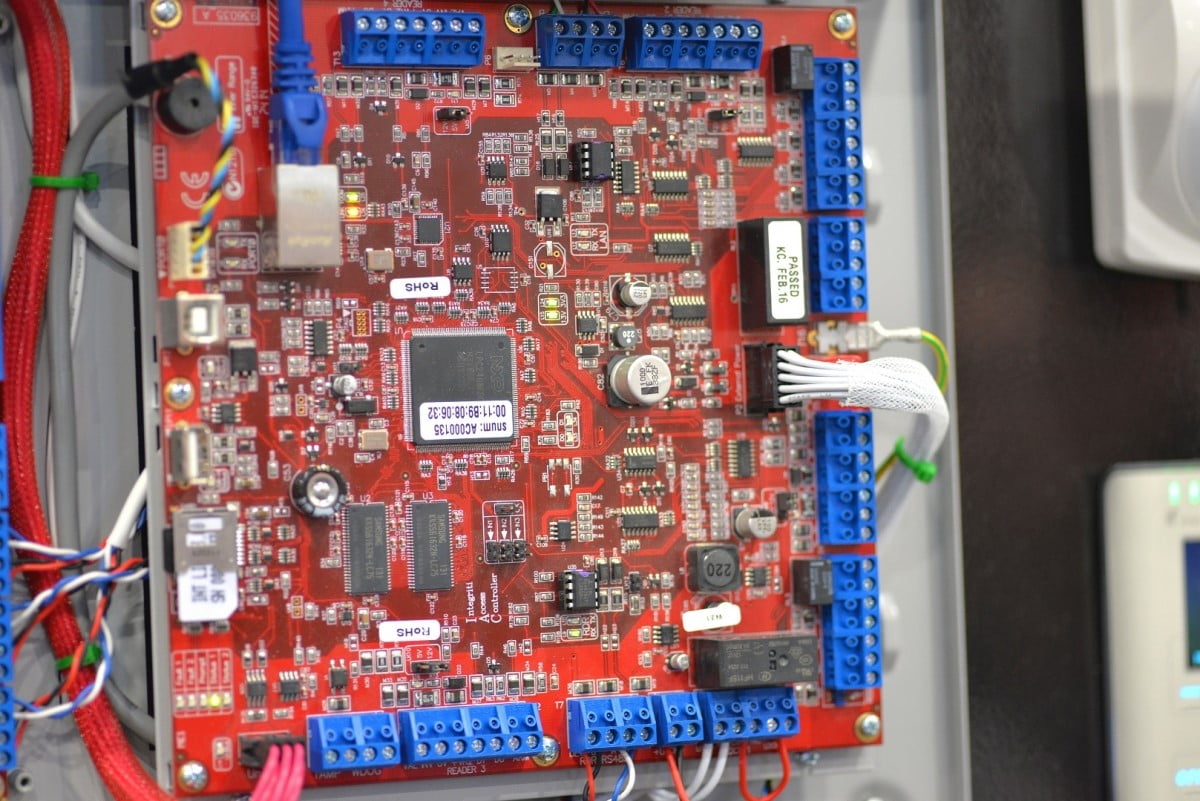
We’ve talked about Inception in detail in SEN in recent months and this compact yet powerful system, with its excellent Commissioning Checklist was one of the highlights of the show, even though we’ve seen it before. Meanwhile Inner Range also showed Infiniti Class 5, which has all the power and functionality of Integriti with 128-bit encrypted zone loops and more. Another great solution was ICT’s Protégé, which is an enterprise-level integrated access control, intrusion and building automation system manufactured in New Zealand. Modular design bolstered by 32-bit RISC processors allows operation in single sites right through to multi-national corporations. Each Protégé GX controller has 24 inputs and a pair of high power outputs but it’s clever stuff like primary and secondary access levels that makes system setup so easy. It’s possible to assign door groups, menu groups, area groups, floor groups and elevator groups to access levels, with the secondary group giving another level of user access. Automation and programmable functions are extensive. A cursory description like this one seems a disservice to the ICT product – Protégé is that sort of a solution.
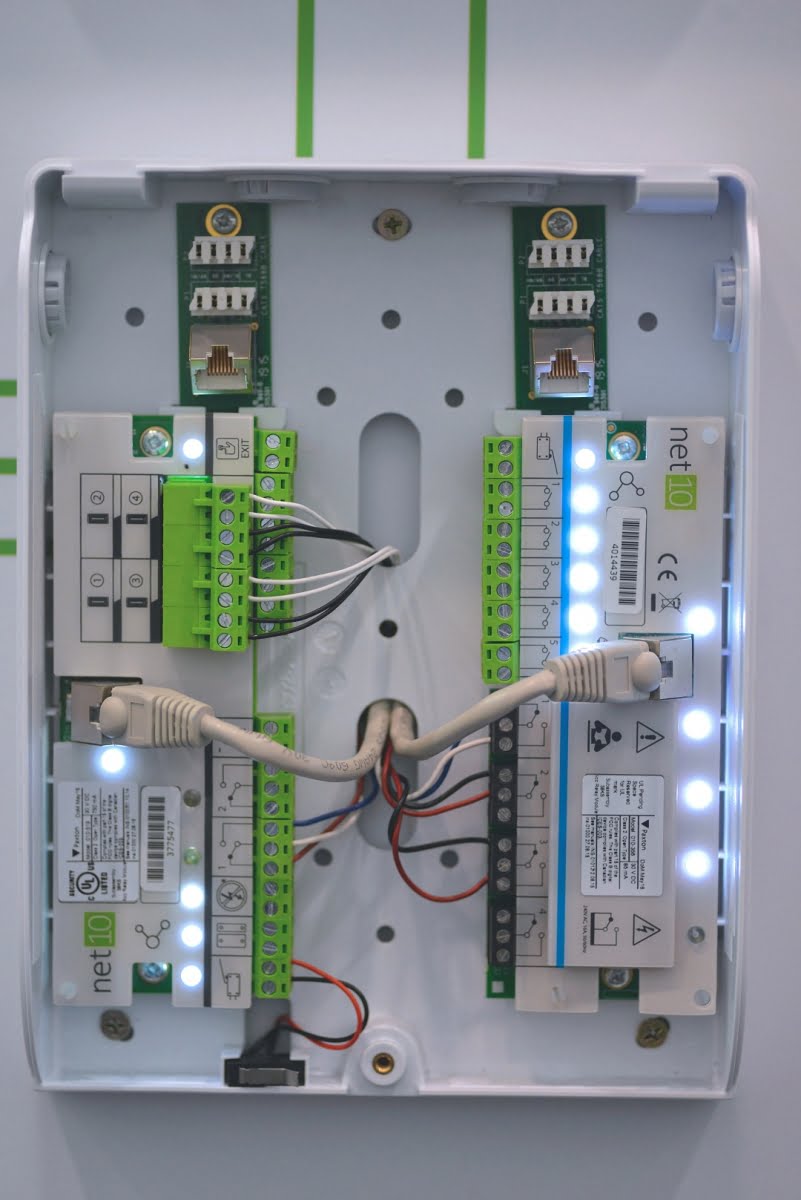
Another access control solution that took my fancy at Security 2016 was Paxton’s net10, which combines access control, video surveillance, intrusion and fire detection, and building management/automation. Same as the net2 Plus, you drive net10 through an HTML5 software GUI that lives in the integrated net10 server, which has a 32GB USB memory which is used for config backups. Each net10 server can support 100 PoE net10 controllers and each controller can support 2 doors and 2 video inputs. The controllers have a Bluetooth Smart gateway and can support 2 net10 connector modules, one of which can support 1 single door, up to readers, as well as a lock relay output and 2 additional outputs. The second connector module supports 5 digital inputs and 4 relay outputs. This module facilitates the creation of triggers and actions via the software, and can be used for a wide range of automation applications. What all this means is that a net10 controller can assume different shapes, managing 2 doors with up to 8 readers, 1 door with up to 4 readers, as well as handling 5 inputs and 4 outputs, or 10 inputs and 8 outputs.
Another new alarm and access control system is the Bosch G Series controller, which features alarm capability with integrated access control and IP video control. G Series supports up to 2000 users and almost 600 alarm inputs, up to 32 areas and 32 doors. There’s a Bosch Remote Security Control App so you can operate the system from any iOS or Android device. Taking this system to another level, G Series also features Bosch Video Management System (BVMS 6.5) integration to you get a single interface to monitor and control intrusion detection and video surveillance. BVMS also has integrated server-based analytics from Ganatec’s Bintelan Analytics platform for facial recognition and number plate recognition.

Gallagher showed its latest version of Command Centre Mobile App at the show – we’ve seen this before and appreciate its ability to extend the functionality of Gallagher systems to remote mobile devices. The company also showed a bunch of other cool things, many of which related to perimeter intrusion deterrent and detection. These latter included enhancements to Gallagher’s powered fence controller and components, including insulators.

Dahua revealed its DHI ASC 1204B, an access control system that will handle 100,000 valid cards and 300,000 records, supports multiple card technologies as well as password, fingerprint and combination authentication. It has TCP/IP or RS-485 interface to PC and Wiegand or RS-485 interface to readers (2/4 door). Features include door time out alarm, intrusion alarm, duress alarm and tamper alarm, anti-pass back, multi-door interlock, multi-card open, support for 128 efficient time and holiday schedules and a system watch dog function.
Meanwhile, IMID Access (In-Motion Identification) identifies users as they walk using a fusion of biometric ID technologies. This functionality This solution integrates with existing security solutions, has self-enrolment, visitor management, real time activity log, a mobile solution for security personnel and more.
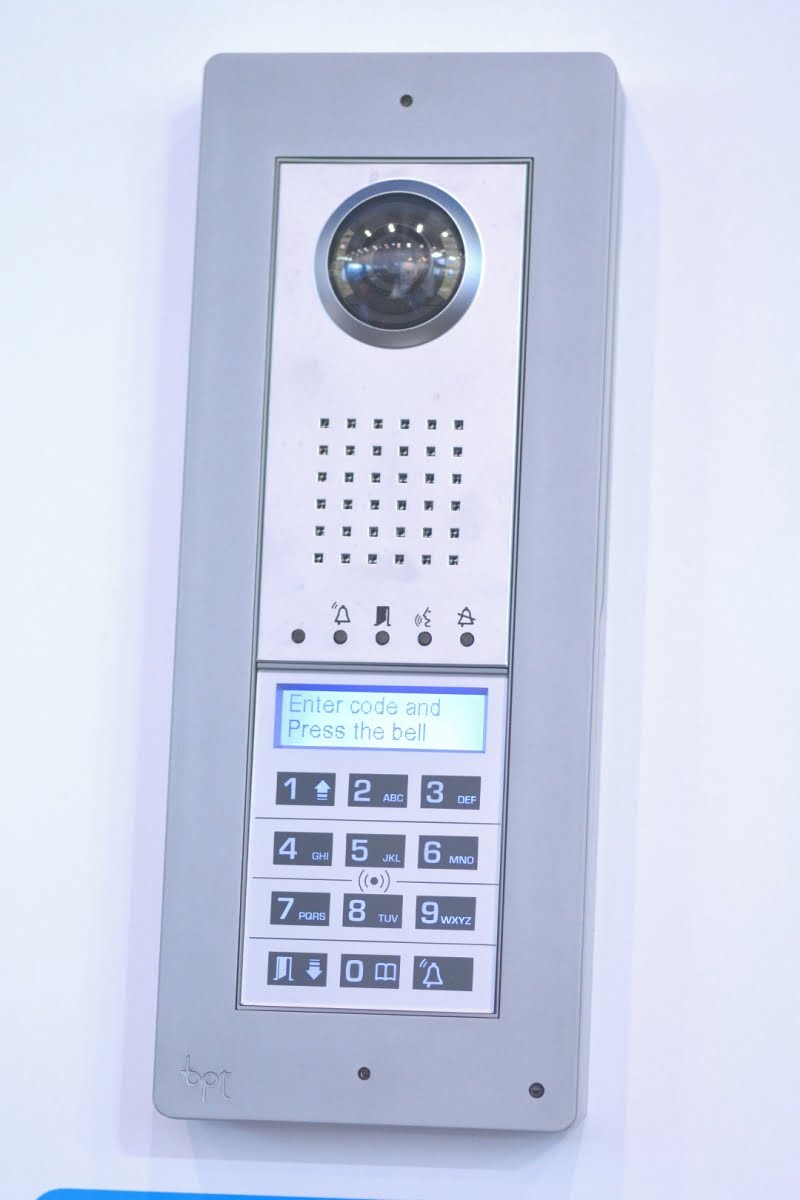
Another new access control product was ASSA ABLOY’s Aperio E100 V3 Series Escutcheon, which is designed to fit Lockwood mechanical 3570 series mortice locks for affordable access control of doors. The E100 V3 Series supports multiple card technologies with key override and internal emergency lever. Battery life is at least 2 years and heartbeat comms is 5-10 seconds. These units offer audit trails and time zones, 200-event audit trail onboard, LED status and low battery signal to EAC.
Tyco’s Kantech EntraPass Security Software V7.0 is a suite of high performance software that allows customers to design and operate any number of doors where card access is required – securely, quickly & efficiently. It has Aperio wireless locks integration and also supports integration with Exacq video management systems, American Dynamics DVRs/NVRs, Kantech INTEVO integrated security platform and DSC PowerSeries control panels.

Another nice offering in the access control space is KSoftware’s C3-100 system, which allows management and real time monitoring and control of access control systems via browser. The C3-400 and Inbio-460 can communicate at 38.4 Kbps via RS-485 configuration or TCP/IP networks. Both store up to 30,000 cardholders, and the InBio-460 stores up to 3000 fingerprint templates. There’s a SDK allowing integration of controllers into existing access control software or to develop new software.
What was new in alarms
Last year when it came to alarm systems we had Ness Mezzo to drool over. This year there was nothing quite so spectacular but that doesn’t mean there weren’t a number of solutions at Security 2016 worthy of attention. I very much liked the Sensormat solution, which employs a network of fibre optics embedded in a robust industrial mat and generates exquisitely detailed detection signals. Simple, tough, high security, low cost and with no moving parts, very reliable.
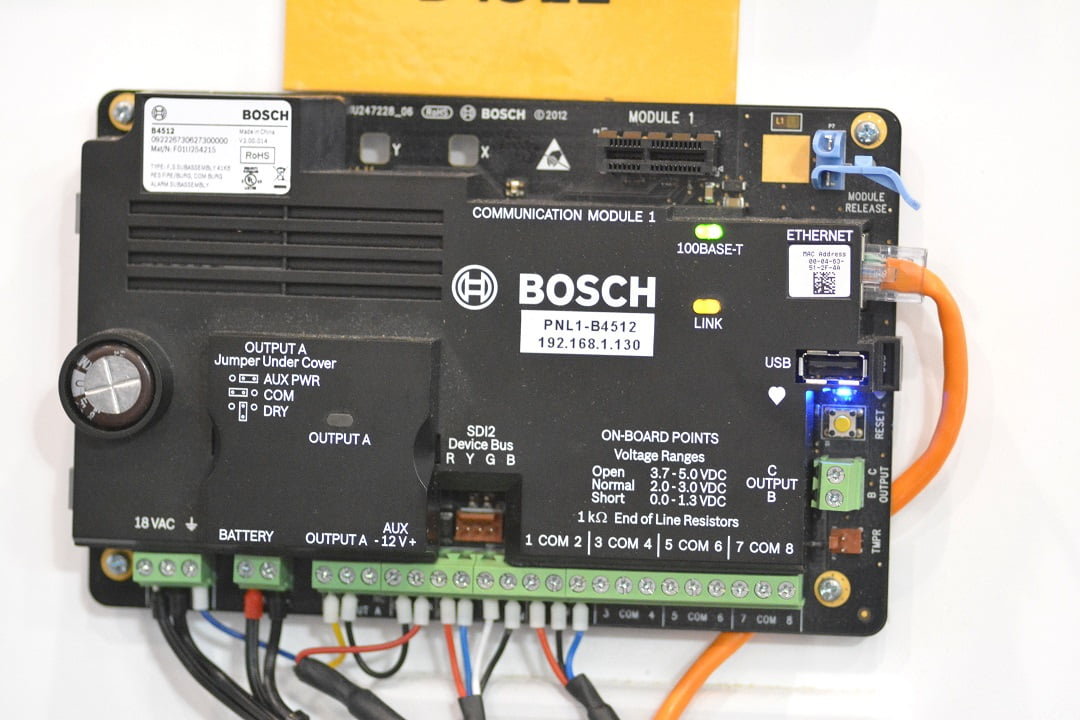
Bosch was showing the B Series B4512 intrusion control panels, which offers 28 zones and 22 areas. The B Series panel has integrated IP comms (RJ45) with DNS support for remote access and alarm reporting – installers can hop into the system and program up via Bosch’s remote programming software. There are plug-in modules for additional comms technologies and thus equipped the panels offer cellular text message notifications of events and Bosch’s Remote Security Control app for the iPhone, iPad or iPod touch. Remote Security Control also allows system arming and disarming and management of connected outputs.
Bosch B Series Control Panels can also be easily programmed to carry out multiple functions with a single keypad command or with the push of a wireless keyfob button. These custom functions enable security dealers to tailor the system to their customers’ specific needs, while providing simple operation. In addition, scheduled events allow for the system to be automatically armed and disarmed at pre-determined times or to perform other functions based on an internal clock and calendar.
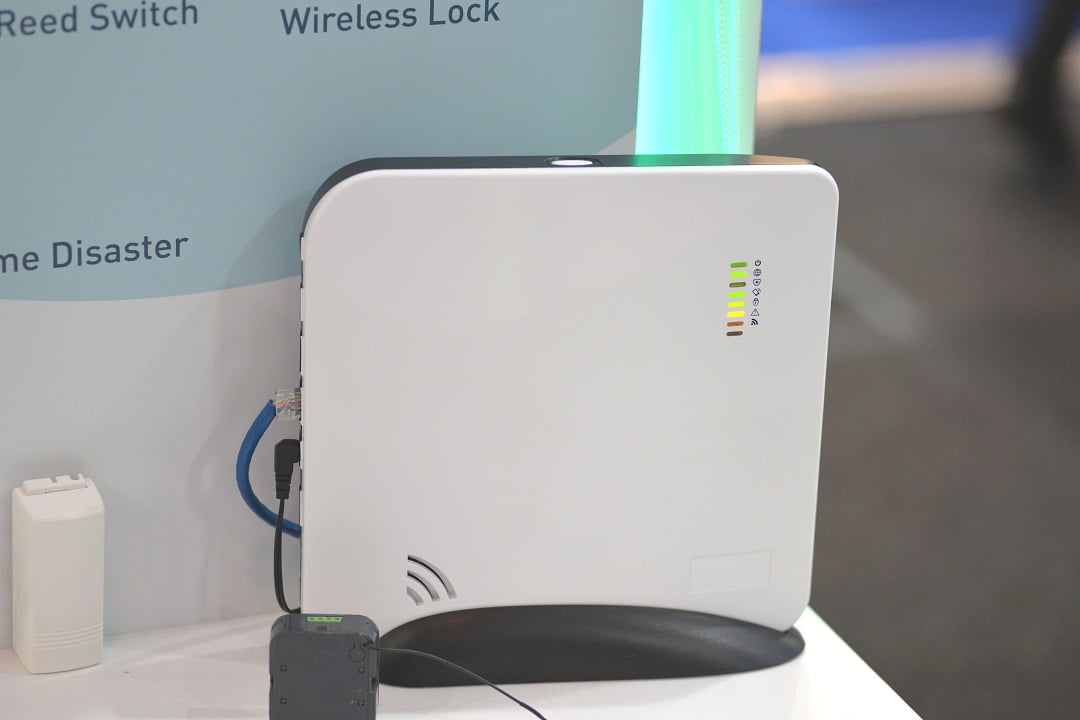
Something else I was keen to get a look at was the Resolution Systems Helix panel from EOS (and others), which is teamed up with Connect 02 (oxygen symbol), which is underpinned by the thoroughly-proven SecureNet service. There’s 100Mbps Ethernet RJ-45, 802.11 b/g/n Wi-Fi with WPS, GSM (optional) and 3G (primary or secondary configuration). There’s encrypted crystal wireless is 433MHz or 110KHz with -115dBm receiver sensitivity and an open air range of 450m and 2.4GHz Bluetooth with 90m range.
The system has 96 wireless zones and you can select from standard door or window movement sensors, Nanomax movement sensors, PIR pet immune sensors, tilt sensors, PIR gimbal sensors, glassbreaks and wireless sirens. There’s a Helipad Bluetooth Smart RF connection between keypad and control panel with a capacitive touchscreen and the system can also be controlled using keyfobs or panic pendants.
One of the standout releases in alarms this year was FSH’s SCEC-approved SL4 FSS1 Door Monitoring Sensor. It replaces traditional reed switch technology with a microprocessor, a smart combination of Hall Effect sensors and a magnetic array plate, allowing the unit to be re-calibrated in case of door drop. Neat, too, the FSH sensor is available in flush or surface mount.
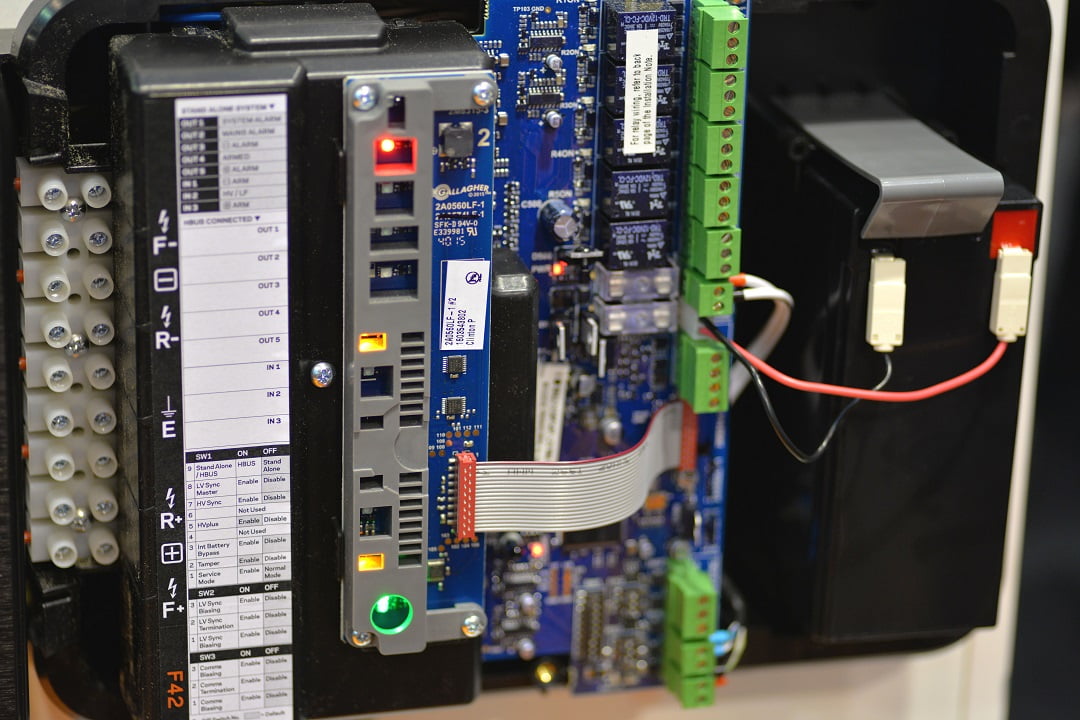
Meanwhile, Gallagher’s new F4 Fence Controllers are designed to actively detect and deter intruder attempts through standalone or fully integrated perimeter solutions. Variable settings increase flexibility and design enhancements enable quicker, easier installation. Independent dual pulse delivers double the deterrent level to a fence zone using HVPlus reactive deterrent technology. Demonstrations of this capability had real snap.
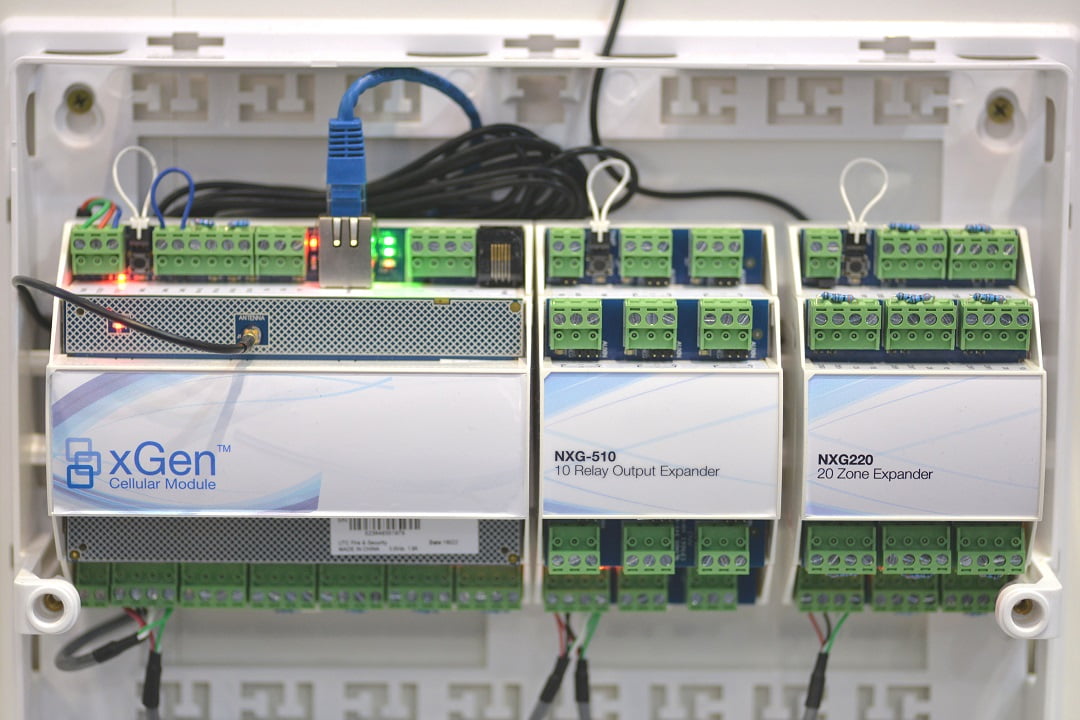
Hills was also showing an interesting hardwired alarm system called X-GEN with an X-GEN cellular module, NXG-510 output expander and NXG-220 zone expander. Apparently, this solution was the last system developed by the endlessly inventive Gabriel Daher when he was at UHS, so its pedigree can’t be disputed. ZeroWire was also on show at Hills with additional functions, including a mobile app and support for locks.
Conclusion
The official winners of Best Product Awards at Security 2016 were Inner Range with Infiniti Class 5, with Fire & Security Hardware’s FSS1 – High Security Door Monitoring Sensor in second place and MOBOTIX M15 Thermal TR coming third. These products all deserved the attention they got, I thought. But there were plenty of other solutions that were very appealing, depending on the nature of your applications.
I liked Hikvision PanaVu – the delivery software was excellent – but I rated Hik’s 4K PTZ as the more elegant solution. Sony’s VB770 is a great low light CCTV camera if high performance is your key criteria – this is a camera I’d love to test on the street. Inner Range Class 5 and Inception are key releases but to my mind Inception is the bigger deal. It puts access control, intrusion and automation into the hands of aspiring thousands of installers, as well as simplifying jobs for Inner Range aficionados who may find Integriti too much solution for some of their smaller installations.
Other products I appreciated were Uniview’s 44x PTZ with 250m IR, Axis Q1615 Mark II with i-CS lens, Panasonic AeroPTZ and Vivotek’s SD9364-EHL, this latter is a lovely camera – compact and powerful and the application of H.265 compression makes it a winner. I also liked Genetec Mission Control, Nx Witness VMS, Paxton net10, Harmony Transaction Player from Sektor, and the locally-developed Sensor Mat detection system, also deserves a closer look for users who have trouble with other detection technologies in challenging environments.
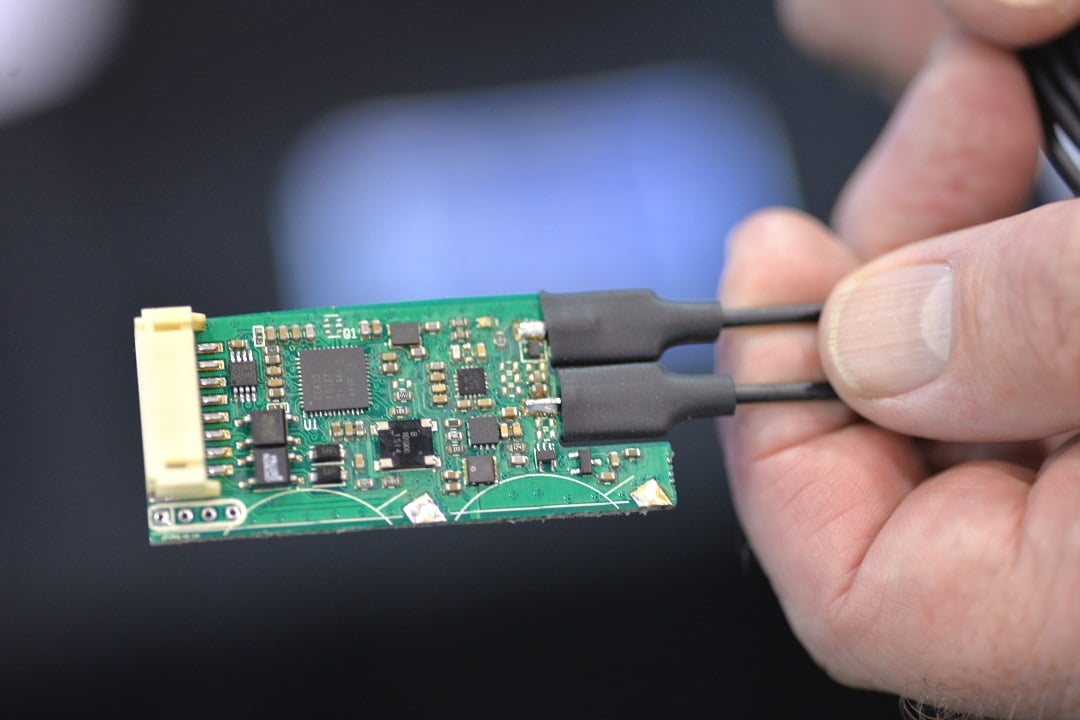
Meanwhile, ISI’s Mobile CCTV Command Centre, which isn’t a product so much as an integration deserves accolades, too. It’s a serious solution built by serious people for serious applications. Avigilon Appearance Search was another great solution at Security 2016 – faced with searching multiple video streams it just works. ♦
By John Adams











